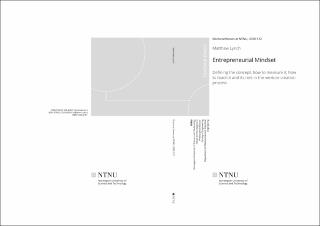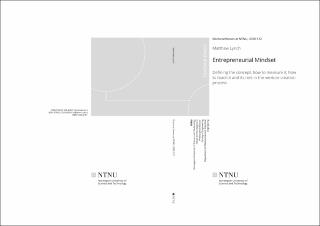| dc.contributor.advisor | Steinert, Martin | |
| dc.contributor.advisor | Andersson, Gunnar | |
| dc.contributor.author | Lynch, Matthew Patrick James | |
| dc.date.accessioned | 2020-04-02T08:09:29Z | |
| dc.date.available | 2020-04-02T08:09:29Z | |
| dc.date.issued | 2020 | |
| dc.identifier.isbn | 978-82-326-4593-0 | |
| dc.identifier.issn | 1503-8181 | |
| dc.identifier.uri | https://hdl.handle.net/11250/2650008 | |
| dc.description.abstract | The world is facing numerous challenges, and entrepreneurship represents one method for introducing solutions to solve these challenges. For this reason, entrepreneurship is more relevant today than ever. Yet when we examine those who want to be entrepreneurs, or generate entrepreneurial outcomes, we see that a great many of them do not succeed. When we dig further we see that there is a cognitive element to this, as nothing physically prevents people from becoming entrepreneurs. We posit that it is an entrepreneurial mindset ("EM") that allows some people to take entrepreneurial actions under circumstances of uncertainty in order to create ventures. This leads to the primary research question of this thesis, which is: what is the role of EM in separating those who take entrepreneurial actions from those who have the intention to take entrepreneurial action but never do?
In order to examine this research question, I first began by examining three sub-questions that inform our overarching research question. The first of these is: how do you define and conceptualise what is meant by an EM? In order to answer this, I begin with an overview of key literature on mindset and cognition. Two themes became apparent to me from reading literature on this topic. The first is that there has been thorough research into individual cognitive elements, such as biases, heuristics, beliefs, roles, schemas, identity, expert cognition, meta cognition and personality - yet none of these individually provides insights into what is EM. The second theme which comes through from examining existing literature is that existing conceptions of EM are focussed on what I describe as "high level descriptions": they describe broad outcomes such as a willingness to act under uncertainty, or an ability to identify and exploit opportunities. These conceptions are overly broad and are focussed on the expected outcomes of having an EM, instead of describing what an EM is. To resolve this gap between individual parts of cognition and high level broad descriptions, I set out to provide a conceptualisation of EM. I define EM as: An automated non-conscious perspective including the sum total of cognitive processes; that lead to an individual's willingness to take action under uncertainty, make errors, learn from those failures and direct that learning to specific goals to best solve the entrepreneurial tasks within the process of venture creation (Lynch & Corbett, 2019). This new conceptualisation of EM is based on bringing across work from the field of cognitive psychology and synthesising prior research from outside of entrepreneurship. What separates the proposed conception of EM from prior literature is an acceptance that is not one thing or concept, but rather it is something far more fluid and changing. This conception allows for both mistakes and learning, and is important as a distinction from existing conceptions of EM.
Having conceived of what we1 mean by EM, the thesis moves onto examining the second researchquestion: how can we measure EM? We show that prior research measures something other than mindset, and it is often focussed on aspects of personality, despite entrepreneurship as field having moved on from personality as a crucial determining factor in entrepreneurial outcomes. Alternative measures also focus on individual elements of cognition, such as risk propensity, need for achievement or meta-cognition. While these elements all play a role in EM, they only partially contribute to our conception of EM. We therefor set out to test a novel method for measuring EM, using language as a proxy for cognition. This is based on the argument that what we talk about and how we talk about it reflects what we think about it and the way we think about it. Based on this argument, our research examines the ways in which expert entrepreneurs use language differently from less expert entrepreneurs. The result is five themes that are consistent with similar work on measuring how expert entrepreneurs think with regards to venture creation.
Having conceived of EM and developed a methodology to measure it, we then set out to examine how to teach EM. This is an important theme based on that bringing about change in the world requires more entrepreneurs to take more entrepreneurial action. This thesis is built around the idea that EM plays a role in giving individuals the mental resources they need to bring ideas into reality. Therefore, finding an appropriate pedagogy that fosters this is crucial. In examining the existing literature on pedagogy, we find that learning from experience has gained popularity, and that within this field, design ("DT") as a practice orientated methodology can be useful for teaching EM.
This leads to the third and final research question: why is DT a useful pedagogy for teaching EM? In investigating this research question I first describe our conception of DT, and explain how this contributes to having students practice the different elements of EM. We then delve into studentreflections on DT to elaborate on what students receive out of this pedagogy. In order to provide some practical suggestions on how to teach DT, we also include a section on the practical aspects of organising teaching interventions based on DT. These suggestions are based on prior experience with teaching DT in the context of entrepreneurship.
Lastly, in order to answer the overarching research question and explain how EM plays a role in entrepreneurial action, I also describe the way EM influences an entrepreneur's world view, and their choice in responding to entrepreneurial stimuluses, such as opportunities. I show congruence between our conception of EM and existing literature and elaborate on the way EM impacts goal achievement/venture creation. I link EM with a model from cognitive psychology called the Rubicon model. This model shows the stages that people move through in their quest to achieve challenging goals, and the role of mindset in this process. The model highlights the two key mindsets used by entrepreneurs: elaborative mindset and implementive mindset.
The thesis is based on 9 individual research articles. These articles use a variety of methods, including qualitative, qualitative, case studies, participant observation, surveys and interviews. The range of articles and methods provide a way to triangulate the perspectives discussed, and each article contributes to the research questions in different ways, with a sense of overlap often existing between the articles. As a body of work, this thesis represents contributions in the form of providing a new conceptualisation of EM and provides a synthesis of existing perspectives. If offers up several new models of the role of EM in influencing behaviour of entrepreneurs. The thesis also provides a new method of measuring EM and provides insight into how to teach EM in a way that has not been fully researched before. Like all pieces of research it also opens many new questions as well as providing new insights on old questions. This thesis plays a role in furthering our insight in the role of EM in creating entrepreneurial outcomes. | |
| dc.language.iso | eng | en_US |
| dc.publisher | NTNU | en_US |
| dc.relation.ispartofseries | Doctoral theses at NTNU;2020:122 | |
| dc.relation.haspart | Paper 1:
Lynch, Matthew Patrick James; Steinert, Martin; Andersson, Gunnar.
Entrepreneurship: What Separates Those Who Do from Those Who Don't
2016 International Conference on Design Creativity (ICDC); 2016 | |
| dc.relation.haspart | Paper 2: Lynch, Matthew Patrick James; Andersson, Gunnar
Levels of Internal Resistance in
Entrepreneurship: a psychology based model
for guiding coaching | |
| dc.relation.haspart | Paper 3:
Lynch, Matthew P.; Corbett, Andrew C.
Entrepreneurial mindset(s) and cycles of learning | |
| dc.relation.haspart | Paper 4: Lynch, Matthew Patrick James; Kamovich, Uladzimir; Andersson, Gunnar; Steinert, Martin. The Language of Successful Entrepreneurs: An Empirical Starting Point for the Entrepreneurial Mindset. Proceedings of the European Conference on Innovation and Entrepreneurship, ECIE 2017 s. 384-391 | |
| dc.relation.haspart | Paper 5: Lynch, Matthew Patrick James; Tuema, Ludovic; Andersson, Gunnar; Steinert, Martin. Entrepreneurial Mindset - an Empirical Starting Point. ISPIM Conference Proceedings 2017 | |
| dc.relation.haspart | Paper 6: Lynch, Matthew Patrick James; Slåttsveen, Kristoffer; Lozano, Federico; Steinert, Martin; Andersson, Gunnar. Examining entrepreneurial motivations in an education context. Proceedings of the International Conference on Engineering Design 2017 ;Volum 9.(87-9) s. 79-88 | |
| dc.relation.haspart | Paper 7: Lynch, Matthew Patrick James; Steinert, Martin; Andersson, Gunnar. Educating entrepreneurs in practical methods with design practices as a guide. I: NordDesign 2016. The Design Society 2016 ISBN 978-1-904670-80-3. s. 158-167 | |
| dc.relation.haspart | Paper 8: Lynch, Matthew Patrick James; Kamovich, Uladzimir; Longva, Kjersti Kjos; Steinert, Martin. Combining technology and entrepreneurial education through design thinking: Students' reflections on the learning process. Technology Forecasting and Social Change 2019 https://doi.org/10.1016/j.techfore.2019.06.015 - Published under a Creative Commons license (CC BY-NC-ND 4.0) | |
| dc.relation.haspart | Paper 9: Lynch, Matthew Patrick James; Kamovich, Uladzimir; Steinert, Martin. Promoting strategic entrepreneurship at the firm level: a case study on training staff within a large organisation. International Journal of Product Development 2019 ;Volum 23.(4) s. 309-325 https://doi.org/10.1504/IJPD.2019.105495 | |
| dc.title | Entrepreneurial Mindset: Defining the concept, how to measure it, how to teach it and its role in the venture creation process | en_US |
| dc.type | Doctoral thesis | en_US |
| dc.subject.nsi | VDP::Technology: 500::Mechanical engineering: 570 | en_US |

